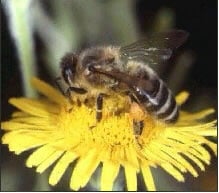Bees

Bees are not classed as pests but their presence may cause a nuisance.
All bees are environmentally friendly and should never be killed.
However, if you consider that you require assistance you may wish to contact one of the Isle of Wight Beekeepers who have volunteered to give advice or assistance to help capture swarms if possible. They are under no obligation to do so and may only assist with honey bees - they are not interested in wild bees.
For details please contact your local Environmental Health Department. Tel: 01983 823000.
Life Cycle
The queen is responsible for reproduction. The drones are fertile male bees that mate with the new queens. The workers are sterile females responsible for feeding the queen, maintaining the hive, gathering pollen and nectar, and protecting the hive.
Identification:
Facts.
Some interesting information:
- The first bee appeared on earth 146-7 million years ago.
- Modern bees appeared 30 million years ago.
- There are between 30,000 to 60,000 bees in an average hive.
- A queen bee can lay between 1,000 to 3,000 eggs in one day.
- A queen bee lives for between 2 to 8 years.
- All worker bees are female.
- The average life of a bee is 7 to 8 weeks from egg to end of forage life.
- Male bees are called drones.
- Honey bees are reluctant to sting because loss of the stinger causes a bee to die.
- The chemical in a bee sting is mellitin.
- A bee can fly up to 8 1/2 miles.
- Bees make honey from nectar.
- Honey is composed mainly of a variety of sugars, traces of pollen, water and enzymes.
- Bees carry nectar in their crop or honey stomach.
- Pollen is carried on the hind (metathoracic) legs.
- Pollen is a source of protein.
PLEASE REMEMBER.
Bees are not a pest and all bees are environmentally friendly and should never be killed.
Bee Stings:
Some people develop acute allergic reactions to bee stings. An allergic reaction becomes evident in less than an hour and consists of extreme difficulty in breathing, heart irregularity, shock, splotched skin, and speech difficulty.
A person showing signs of an allergic reaction
should see a medical doctor immediately.
Unlike many other insect venoms, bee venom is water soluble, not fat soluble, and so must be injected into moist tissue to be effective. It is haemorrhagic, unlike snake venom, which is a coagulant. Bee venom is a clear liquid, which forms greyish white crystals when exposed to air.
For more information regarding this Leaflet please contact:
Environmental Health Service
Jubilee Stores
The Quay
Newport
Isle of Wight
PO30 2EH
Telephone: 01983 823000
Facsimile: 01983 529804
©Isle of Wight Council, May 2004
Page last updated on: 30/08/2007





